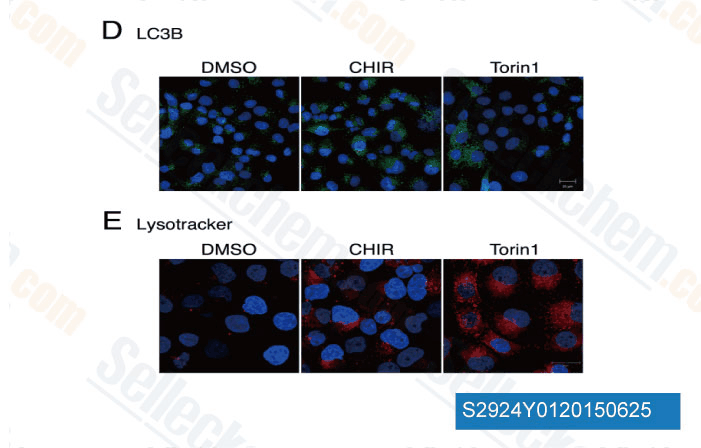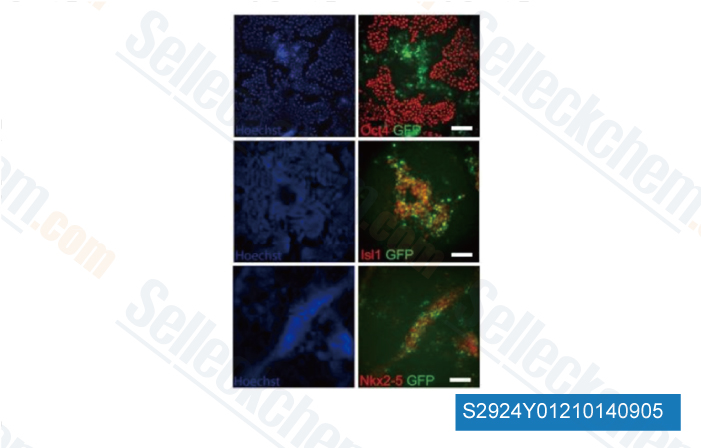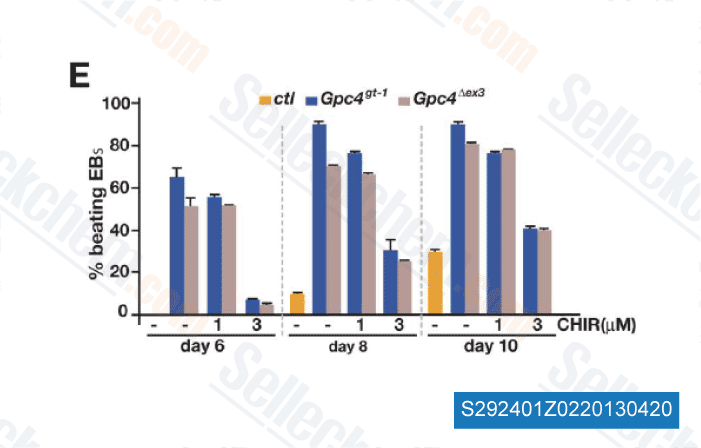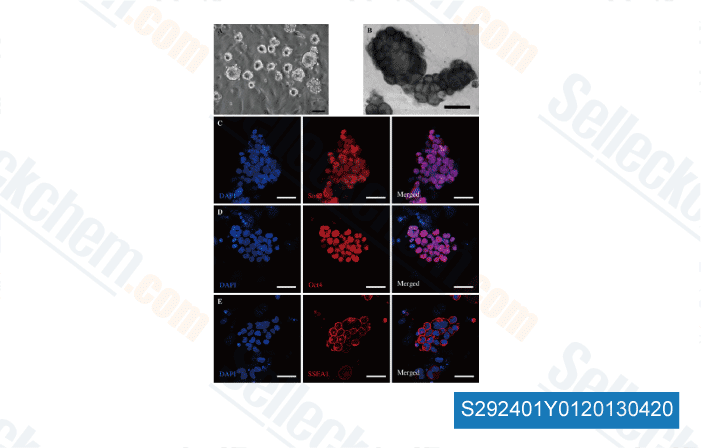|
Toll Free: (877) 796-6397 -- USA and Canada only -- |
Fax: +1-832-582-8590 Orders: +1-832-582-8158 |
Tech Support: +1-832-582-8158 Ext:3 Please provide your Order Number in the email. |
Technical Data
| Formula | C22H18Cl2N8.HCl |
|||
| Molecular Weight | 501.8 | CAS No. | 1797989-42-4 | |
| Solubility (25°C)* | In vitro | DMSO | 100 mg/mL (199.28 mM) | |
| Ethanol | 100 mg/mL (199.28 mM) | |||
| Water | Insoluble | |||
|
* <1 mg/ml means slightly soluble or insoluble. * Please note that Selleck tests the solubility of all compounds in-house, and the actual solubility may differ slightly from published values. This is normal and is due to slight batch-to-batch variations. * Room temperature shipping (Stability testing shows this product can be shipped without any cooling measures.) |
||||
Preparing Stock Solutions
Biological Activity
| Description | Laduviglusib (CHIR-99021; CT99021) HCl is hydrochloride of CHIR-99021, which is a GSK-3α/β inhibitor with IC50 of 10 nM/6.7 nM; CHIR-99021 shows greater than 500-fold selectivity for GSK-3 versus its closest homologs Cdc2 and ERK2. CHIR-99021 is a potent pharmacological activators of the Wnt/beta-catenin signaling pathway. CHIR-99021 significantly rescues light-induced autophagy and augments GR, RORα and autophagy-related proteins. | ||||
|---|---|---|---|---|---|
| Targets |
|
||||
| In vitro | CHIR-99021 shows greater than 500-fold selectivity for GSK-3 versus its closest homologs CDC2 and ERK2, as well as other protein kinases. Furthermore, CHIR-99021 shows only weak binding to a panel of 22 pharmacologically relevant receptors and little inhibitory activity against a panel of 23 nonkinase enzymes. CHIR-99021 induces the activation of glycogen synthase (GS) in insulin receptor-expressing CHO-IR cells with EC50 of 0.763 μM. [1] In addition to simulating the actions of insulin, inhibition of GSK-3 by CHIR-99021 (3 μM) increases free cytosolic β-catenin by 1.9-fold, mimicking the canonical Wnt signaling pathway in 3T3-L1 preadipocytes. During any of the first 3 days of differentiation, CHIR-99021 treatment inhibits the preadipocyte differentiation with IC50 of 0.3 μM by blocking induction of CCAAT/enhancer-binding protein α (C/EBPα) and peroxisome proliferator-activated receptor γ (PPARγ). [2] Unlike lithium chloride and AR-A014418, CHIR-99021 treatment does not reduce the viability of INS-1E cells even at high concentrations. Instead, CHIR-99021 robustly increases the rate of proliferation of INS-1E cells in a dose-dependent manner, and significantly inhibits INS-E cell death induced by high glucose and high palmitate in a concentration-dependent manner. CHIR-99021 promotes primary beta cell replication in isolated rat islets at concentrations as low as 1 μM, with 2-3 fold increase of cell replication at 5 μM of CHIR-99021 treatment. [3] |
||||
| In vivo | Oral administration of CHIR-99021 at 30 mg/kg enhances glucose metabolism in a rodent model of type 2 diabetes, with a maximal plasma glucose reduction of nearly 150 mg/dl 3-4 hours after administration, while plasma insulin remains at or below control levels. Oral administration of CHIR-99021 at 16 or 48 mg/kg 1 hour before oral glucose challenges in ZDF rats significantly improves glucose tolerance with 14% and 33% reduction in plasma glucose at 16 mg/kg and 48 mg/kg, respectively, and the higher dose of CHIR-99021 also reduces hyperglycemia before the oral glucose challenge. [1] |
Protocol (from reference)
| Kinase Assay: |
|
|---|---|
| Cell Assay: |
|
| Animal Study: |
|
References
|
Customer Product Validation

-
Data from [Data independently produced by J Biol Chem, 2015, 290(9), 5592-605 ]

-
Data from [Proc Natl Acad Sci U S A, 2012, 109(27):E1848-57]

-
Data from [Stem Cells, 2012, 30, 1863-1874]

-
Data from [J Genet Genomics, 2012, 39, 643e651]
Selleck's Laduviglusib (CHIR-99021) HCl has been cited by 770 publications
| Medium from human iPSC-derived primitive macrophages promotes adult cardiomyocyte proliferation and cardiac regeneration [ Nat Commun, 2025, 16(1):3012] | PubMed: 40148355 |
| RSAD2: A pathogenic interferon-stimulated gene at the maternal-fetal interface of patients with systemic lupus erythematosus [ Cell Rep Med, 2025, S2666-3791(25)00047-3] | PubMed: 39983716 |
| Nanosensor-based imaging of realtime dopamine release in neurons derived from iPSCs of patients with Parkinson's disease [ Mater Today Bio, 2025, 31:101485] | PubMed: 39906200 |
| NLRP7 maintains the genomic stability during early human embryogenesis via mediating alternative splicing [ Commun Biol, 2025, 8(1):125] | PubMed: 39865169 |
| A developmental atlas of mouse vestibular-like inner ear organoids [ iScience, 2025, 28(2):111817] | PubMed: 39967872 |
| Generation of two induced pluripotent stem cell lines from Loeys-Dietz syndrome patients carrying heterologous mutation of TGFBR1 [ Stem Cell Res, 2025, 83:103663] | PubMed: 39884159 |
| Protocol for differentiating cardiomyocytes and generating engineered heart tissues from human feeder-free extended pluripotent stem cells [ STAR Protoc, 2025, 6(1):103576] | PubMed: 39893639 |
| Symbolic recording of signalling and cis-regulatory element activity to DNA [ Nature, 2024, 10.1038/s41586-024-07706-4] | PubMed: 39020177 |
| Symbolic recording of signalling and cis-regulatory element activity to DNA [ Nature, 2024, 632(8027):1073-1081] | PubMed: 39020177 |
| DNA-guided transcription factor cooperativity shapes face and limb mesenchyme [ Cell, 2024, 187(3):692-711.e26] | PubMed: 38262408 |
RETURN POLICY
Selleck Chemical’s Unconditional Return Policy ensures a smooth online shopping experience for our customers. If you are in any way unsatisfied with your purchase, you may return any item(s) within 7 days of receiving it. In the event of product quality issues, either protocol related or product related problems, you may return any item(s) within 365 days from the original purchase date. Please follow the instructions below when returning products.
SHIPPING AND STORAGE
Selleck products are transported at room temperature. If you receive the product at room temperature, please rest assured, the Selleck Quality Inspection Department has conducted experiments to verify that the normal temperature placement of one month will not affect the biological activity of powder products. After collecting, please store the product according to the requirements described in the datasheet. Most Selleck products are stable under the recommended conditions.
NOT FOR HUMAN, VETERINARY DIAGNOSTIC OR THERAPEUTIC USE.
